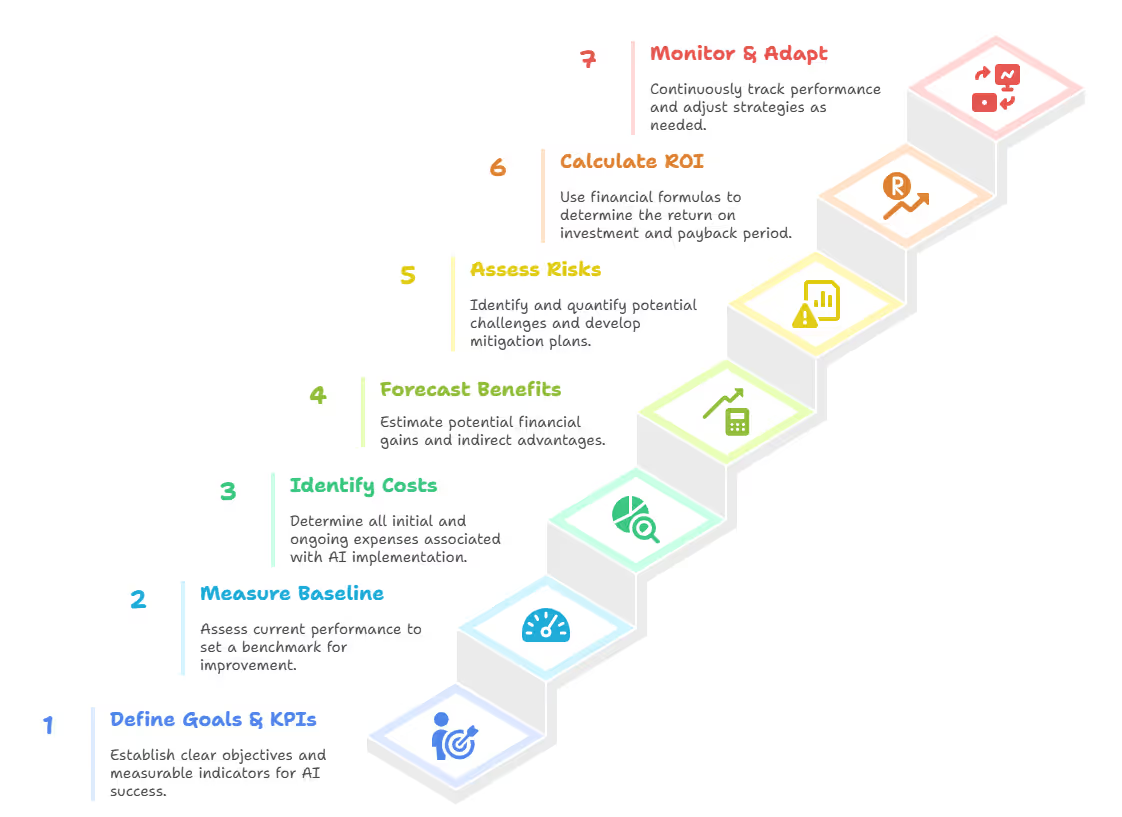How to Measure ROI of Ethical AI Implementation

How to Measure ROI of Ethical AI Implementation in Enterprises?
The ROI of ethical AI in enterprises can be measured through both financial and non-financial gains. Key indicators include reduced compliance costs, fewer legal or reputational risks, higher customer trust, improved employee engagement, and stronger brand value. Ethical AI also drives efficiency and innovation while ensuring long-term resilience to regulations and market changes.
As a CTO at a SaaS company, I've spent over a decade working closely with U.S. business leaders. I've guided countless projects from their first idea to showing big results. Everyone talks about AI, but for many USA decision makers who give projects – especially CEOs and fellow CTOs – the key question isn't if AI is powerful.
It's how that power turns into clear business value.
We're not discussing theories; we're talking about building a solid plan to calculate AI ROI.
Key Takeaways for Business Leaders:
- Calculate AI ROI: Understand your actual return on investment for AI projects.
- AI ROI Framework: Use a proven method to measure both direct financial gains and indirect strategic benefits.
- Measure AI ROI: Get a step-by-step guide to put numbers on AI's value.
- Enterprise AI ROI: Learn how large organizations specifically benefit and what tools help.
- AI ROI Benefits: See real-world examples of how AI drives growth and saves money.
ROI of Ethical AI Implementation in Enterprises:
1. Financial and Risk-Reduction KPIs
- Compliance Cost Savings: Track reduction in legal fees, fines, or penalties avoided by adhering to regulations (e.g., GDPR, AI Act).
- Incident Avoidance: Measure costs avoided from security breaches, biased decisions, or reputational crises linked to unethical AI.
- Audit Efficiency: Compare the time and cost of AI system audits before and after embedding ethical guidelines.
2. Customer and Market Impact KPIs
- Customer Trust and Satisfaction: Use surveys, Net Promoter Score (NPS), or customer retention rates to track improved perception of fairness and transparency.
- Brand Reputation Metrics: Monitor social sentiment analysis, press coverage, and brand equity scores.
- Market Differentiation: Assess increased sales or partnerships attributed to positioning the company as a responsible AI adopter.
3. Operational Performance KPIs
- Error Rate Reduction: Compare the frequency of flawed or biased outputs before and after ethical safeguards were applied.
- Efficiency Gains: Measure speed and accuracy of decision-making, reduced manual oversight, or fewer escalations.
- Integration Success: Track deployment times, adoption rates, and compatibility with existing enterprise systems.
4. Employee and Innovation KPIs
- Employee Trust and Engagement: Monitor surveys on confidence in AI systems and willingness to use them.
- Productivity Gains: Compare output from teams supported by ethical AI vs. unsupported teams.
- Innovation Outcomes: Count new products, services, or features made possible through ethically designed AI.
5. Long-Term Sustainability KPIs
- Regulatory Readiness: Evaluate how easily systems adapt to new ethical and compliance standards.
- Risk Resilience: Track how quickly the enterprise identifies and mitigates emerging AI risks.
- Stakeholder Alignment: Measure board-level and investor confidence in responsible AI practices.
Putting it into practice: Enterprises can assign weightings to each KPI category based on strategic priorities. For example, a financial services firm might focus more on compliance cost savings and risk avoidance, while a consumer-facing company might emphasize customer trust and brand value. Over time, combining financial indicators with qualitative measures gives a clearer picture of ROI.
The AI ROI Calculation Framework: A Step-by-Step Plan for Enterprise
Building a strong AI ROI framework needs a clear, organized approach.
As a CTO, I push for a method that combines careful financial review with looking ahead strategically.

Define Clear Goals & Key Performance Indicators (KPIs):
- Before any project starts, clearly state what you want the technology to achieve. Is it to cut costs, grow revenue, make customers happier, or a mix of these?
- Set up KPIs that you can measure, and tie them directly to these goals. For example:
- Cost Savings: Lower operating spending by X%
- Revenue Growth: Increase conversion rate by Y%
- Customer Happiness: Raise Net Promoter Score (NPS) by Z points
- Efficiency: Cut processing time by A hours
- My Tip: Don't use vague goals. "Improve efficiency" isn't a KPI. "Reduce average time to fix customer support tickets by 30% using automated systems" is.
Measure Your Current Performance (Baseline):
- Measure how you're doing right now against your chosen KPIs before you put the new technology in place. This starting point is essential for showing real improvement.
- Example: Today, the average time to fix a customer support issue is 10 minutes. This is your baseline for how new technology will make a difference.
- Identify & Put Numbers on All Costs:
- Initial Investment: This includes software licenses, hardware, data infrastructure, development costs (whether your team does it or you hire a vendor), and setup costs to get everything working together.
- Ongoing Costs: Think about maintenance, preparing and labeling data, training the models, cloud computing expenses, and the staff needed to oversee and analyze the system's work.
- Missed Opportunities (Opportunity Costs): What are you not doing or investing in by putting money into this specific project? This is often overlooked but important for a full ROI analysis.
Forecast & Quantify Benefits:
- For each direct financial gain, assign a projected monetary value. This requires realistic estimates, often based on results from small pilot programs or what other companies in your industry have achieved.
- For indirect benefits, consider using proxy metrics. For example, better customer experience might mean fewer customers leaving, which you can then translate into saved revenue.
- You can use an ROI value calculator (or build one yourself) to project potential gains. This tool should let you adjust different variables to see how your ROI changes under different conditions.
Assess Risks & Plan How to Deal with Them:
- Spot any potential risks: problems with data quality, difficulties in integrating new systems, ethical concerns, unfair system results, or employees not wanting to use the new tools.
- Put a number on the possible impact of these risks and develop clear plans to avoid or reduce them. This makes your AI ROI calculation much more realistic.
Calculate ROI and Payback Time:
- Simple ROI Formula: This is the most common way to look at it.
ROI=Total Costs(Total Benefits−Total Costs)×100%- Payback Period: This tells you how long it takes for the money you gain to equal the money you spent.
-
Payback Period=Annual Net Benefit \ Initial Investment - For bigger, longer-term projects, consider using Net Present Value (NPV) and Internal Rate of Return (IRR). These methods account for the changing value of money over time.
- Net Present Value (NPV): This number tells you the current value of all future money coming in and going out from a project. If NPV is positive, the project is likely a good investment.
-
NPV=∑t=0n(1+r)tCFt - Where:
CFt = Net money flow (benefits minus costs) at time tr = Discount rate (the return you expect to make)t = The specific time periodn = Total number of time periods for the project
- Internal Rate of Return (IRR): This is the exact discount rate that makes the NPV of a project's cash flows equal to zero.
If your calculated IRR is higher than your company's required return rate, the project is generally considered good.
- Monitor Continuously & Adapt:
- AI ROI measurement isn't a one-time thing. Keep watching your KPIs regularly after you've implemented the technology.
- Models and business needs change. You need regular retraining and optimization, which affects both ongoing costs and benefits.
- Use feedback loops to improve your AI ROI calculation and project guesses as you go.
Choosing the Right AI ROI Software Enterprise Tools
For large companies, figuring out ROI by hand can be difficult and prone to errors.
This is where specialized AI ROI software enterprise solutions really help.

These platforms often provide:
- Integrated Data Gathering: They connect to various data sources to automatically pull in all the relevant cost and benefit data.
- Predictive Modeling: They use smart analysis to forecast potential returns with greater accuracy than manual methods.
- Scenario Planning: These tools let decision-makers test out different assumptions and instantly see how those changes impact the projected ROI.
- Clear Dashboards & Reports: They visualize real-time ROI metrics and present them in easy-to-understand formats for CEO, CTO, USA Decision Makers who give projects.
While general business intelligence tools can offer some insights, dedicated enterprise software AI ROI tools are built specifically to handle the unique complexities of smart technology investment.
This includes things like how well the system performs, data management costs, and the often indirect ways these tools deliver value.
Common Traps to Avoid When Calculating AI ROI for Enterprises
Even with a good framework, it's easy to make mistakes.
Watch out for these common traps:
- Ignoring Hidden Costs: Don't just count the software license. Factor in data cleaning, staff training, integration work, and ongoing maintenance. These can add up fast.
- Over-Estimating Benefits: Be realistic with your projections. A 100% efficiency gain sounds great, but is it truly achievable? Base your forecasts on small-scale tests or industry benchmarks, not just optimism.
- Not Measuring a Baseline: If you don't know where you started, you can't prove improvement. Always measure your "before" state.
- Forgetting Time Value of Money: A dollar today is worth more than a dollar tomorrow. For long-term projects, use NPV and IRR to get a truer picture of value over time.
- Focusing Only on Tangibles: Don't forget the softer benefits like better employee satisfaction or stronger brand reputation. While hard to quantify directly, they contribute to overall business health.
- Lack of Continuous Monitoring: Systems and business needs change. What gives ROI today might not tomorrow. Regularly check and update your calculations.
Real-World Examples of AI ROI Benefits in Action
To make the AI ROI benefits clearer, let's look at a couple of industry-specific examples that matter to U.S. manufacturers and global IT buyers.
Making Smart Tech a Key Business Move, Not Just a Trend
For any CEO, CTO, USA Decision Maker who gives projects, knowing how to calculate AI ROI is no longer optional. It's fundamental for steady growth and staying competitive. By using a clear AI ROI framework that accounts for both direct financial gains and important indirect benefits, companies can move past the excitement and truly use smart technology as a strong tool for creating real value.
At my SaaS company, we found that the discipline of AI ROI measurement doesn't just make investments look good. It also refines project plans, uses resources better, and ultimately drives the kind of new ideas that bring measurable returns year after year.
Let’s talk about how a tailored AI ROI calculation can empower your next big technology initiative.

